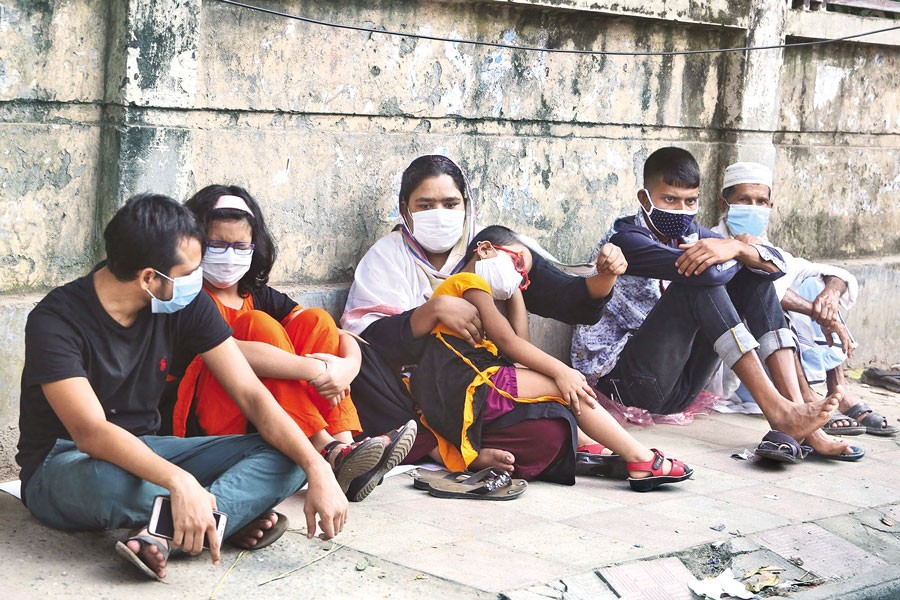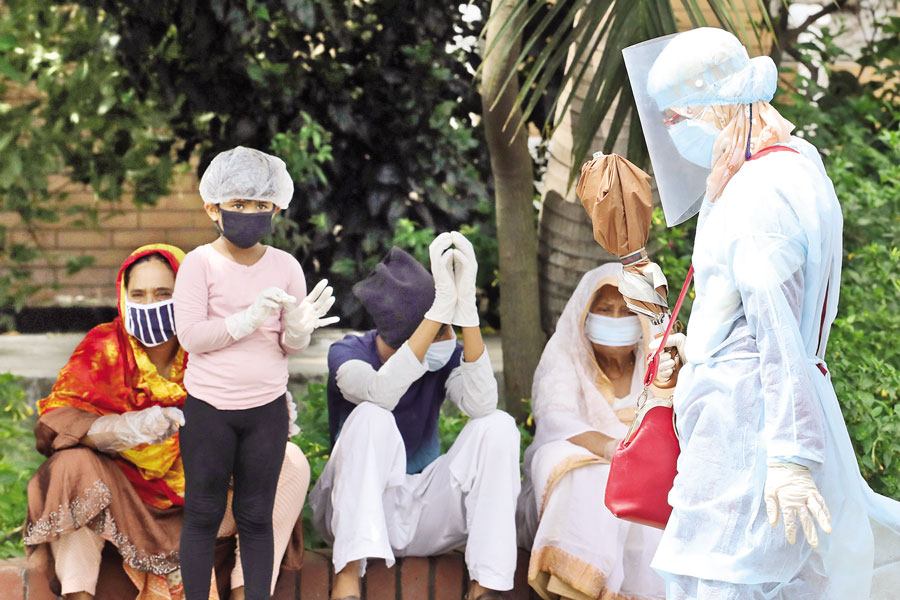
Pandemic and country’s graduation prospect
The good, bad and ugly options
Imtiaz A. Hussain | Tuesday, 10 November 2020

 This year’s corona virus (Covid-19) pandemic will undoubtedly shake society everywhere. The key policy-making puzzle is: should responses be reactionary or anticipatory? Do we take the pandemic as and how it unfolds, or do we look beyond ‘emergency-room’ responses? Long-term planning needs innovation. Is Bangladesh ready for an upscale upswing?
This year’s corona virus (Covid-19) pandemic will undoubtedly shake society everywhere. The key policy-making puzzle is: should responses be reactionary or anticipatory? Do we take the pandemic as and how it unfolds, or do we look beyond ‘emergency-room’ responses? Long-term planning needs innovation. Is Bangladesh ready for an upscale upswing?
Beginning with the country’s ‘known’ features and ‘commitments, we can try to chalk out how to preserve what we have while climbing towards our vision. Just as the pandemic began, we boasted a global-leading 8% annual growth-rate, which is a sine qua non to make Vision 2041, of becoming a ‘developed country’ (DC), possible. This pandemic year, while the World Bank predicts a 1.6% and the International Monetary Fund 4.4% annual growth, both still among the leading global rates, how Vision 2041 will deliver against the 4.4% global economy shrinkage and low-wage workers being booted needs recalculation.
Today we witness trickles of what will become tides by the end of the 2020-21 fiscal year: up to 650,000 of the country’s 10-odd million workers abroad returned between January and March due to plummeting oil prices; and since 200,000 massive jobless emigrants have already because of the pandemic (almost half from the Middle East, as registered at the Expats Welfare Desk in Shahjalal International Airport; while the International Organization of Migration says three-quarters of them still remain unemployed); remittances have shrunk by one-quarter to one-third of the 12-5 billion USD received annually previously, in spite of a surge in the first three 2020 months; and after recovering from cancelled orders, automation, though under 10% of all RMG (ready-made garments) plants now, is set to climb to 25% by 2025 (as Bangladesh Garments Manufacturers and Exporters Association sources say).
Stop-gap measures to absorb these shocks include cutting wages and lowering already low RMG wages, sending diplomats to rack up more migrant deals, and slashing controls to seduce more foreign investors for our vaulted booming export-processing zones. We should also anticipate as many ‘worse-case’ scenarios as possible, and explore new avenues as future job-creators and income-earners. Then we will know what is likely to go well (the good), where we may stumble (bad), the idea being minimizing expected losses or moving out of declining industries, and how to avoid being haunted like a ghost (ugly).

Somehow bound to come out, some people do seriously follow health protocols offering assurance to each other — FE Photo
The Good: Automation opens the progress escalator, much like the 1974 MFA (Multi-fiber Agreement) quotas did to bring foreign RMG plants here. Adopting Digital Bangladesh illustrates a mindset already moving in that direction, while ongoing RMG reconfigurations reaffirms there is more juice left in our dominant industry. New opportunities and playgrounds aside, automation also digs into five-decades of development in different ways. It (a) supplies outlets for the accumulating pool of IT (information technology) graduates, while upgrading our IT skills, thus showing our educational infrastructure is viable enough steer us through the transition; (b) whets our tongues with increasing material tastes, seemingly a necessity in this intellectually-driven unfolding Fourth Industrial Revolution; and (c) ‘social distances’ marginal jobs, as value-added infusions open multiple upper-level service-sector doors. In short, long-term pandemic victory, as opposed to halting short-term containment, cannot but hasten our DC rendezvous: our mindset and economic fulcrum have been shifting towards software cultivation and hardware upgrading from our generations-long low-wage identity long enough to not be denied. Just as our RMG ‘(Economic) Rock of Gibraltar’ shifts from feeding standardized products to haute-couture, so too must partner sectors and income-earners step in.
Global economic conditions may be more turbulent: RMG buyer countries rekindling their own automated RMG production; trade hollowing out, as it did midway through 2020; ‘social distancing’ within factories imposing a huge burden upon low-wage RMG workers worldwide; and massive unemployment, and with it, unprecedented bailouts. Already over 30 billion BDT has been handed out this fiscal year to cover pandemic industrial exigencies in Bangladesh, but over time the Bangladesh work-force will just have to show more skills, comparable to industry-level workers abroad. Veteran developed countries today also faced a similar predicament in the 1920s and 1930s: another pandemic, the spread of assembly-line production, and agricultural mechanization produced the greatest depression of the 20th Century and the most violent competition in World War II. They still got to where they are today. Our 2040s destiny demands this invocation. If the pandemic catalyzed that shift, how we retrain and reabsorb displaced workers and climb the technological ladder will show whether we learned our lessons well, and if we did, how we can chip in to pre-empt global conflict.
The journey from low-wage to higher-wage production breeds new consumption patterns, necessitating new production patterns. Every progress escalator begins with basic goods (clothing, food, medicine, and so forth), but two factors shed light on the quality of reaching the ultimate luxurious upper-end: the speed at which it climbs (as with information technologies rather than assembly lines, automobiles rather than motor-cycles or buses, fashion-driven apparel instead of the basics, and so forth); and how we absorb the changes and soften the pain. Both, in turn, demand stepping outside business nexuses: building complementary (and increasingly) environmental, medical, political (governmental), and social infrastructures pave the way.
Ongoing mega-project construction offers one outlet to job availabilities. These do not immediately satisfy job demands, but as they evolve many new social infrastructures in the pipeline (like hospitals) step up, just as maintaining old infrastructures and simply keeping them functional permits other job-creation slews. New building models may reflect pandemic lessons: tall buildings getting smaller, congestion controls expanding, and recreation begging attention. These feed DC needs. Serving as the pandemic’s ‘invisible hand’, they augment the growing demands for safer, longer, and more viable living, thus consolidating a DC identity.
More than anything else, not only will these new construction/production arenas sprout, but so too new production items. We have been exploring sectors even higher up the value-chain, both with ICT (information and communications technologies)-driven Digital Bangladesh plans to open high-tech parts, IT (information technologies) schools and other public spaces and new industrial products, in addition to building ships for foreign customers, for example, in South Korea, while assembling automobiles and motor-cycles now dot our industrial landscape. Catering to them demands even more highways and ports, particularly urban transportation renewals not just metro-trains, but also free-flowing buses and automobiles, if we are to minimize the costs of climbing the developmental ladder: at least 10 megaprojects address these, at a hefty 39 billion USD cost (5 for buildings, 3 for transportation corridors,1 for energy, and 1 for recreation). In addition, about 100 earmarked economic zones under the 2010 Bangladesh Economic Zones Act (with 37 in the public sector, 29 private, and 4 with foreign investors), have begun spadework: only in October 2020 the prime minister inaugurated 24 new zones, while uplifting 65 others. That 15 of them emphasize science and technology and 3 recreational reiterate the Vision 2041 DC imperative. New export income flowing in from these new high-skilled sectors would relieve our RMG sector, and ease the automated transition.
One last arena of many other sectors worth discussing under this ‘good’ ledger is the rather uncoordinated growth of our expatriate population, and even the emigrant stock. With them, greater travel, tourism, and the entire hospitality sector is poised to boom, as too the demand for more ‘foreign’ products and lifestyles. More sophisticated cultivation is in order, since a far more demanding and nuanced customer pool is in the making.
These are the DC stuff. What the pandemic did was to not just thrust them upon us, albeit a little too prematurely, but to also illustrate how pivotal an alternative they could become for any DC upgrade. We can heed the lessons, as some always will (for example, our early Digital Bangladesh plunges), or we could shun them aside since the certainty of current income typically outweighs expectations of better-quality future income. Here, one bird in the hand may not be worth more than the proverbial two in the bushes: transitions must transgress proverbs, conservatism, and safeguards. We can now afford to do so, and we must before our next, more conscientious, yet less forgiving generation chastises us for not doing so.
The physical setting is poised to change irreversibly (mega-projects on infrastructure, work culture abandoning low-wage manufacturing work, and so forth), but it is in the mental, or intellectual setting where changes will become more telling. Online-education, which was already on the country’s launching-pad before the pandemic, is now set to invade the country, thereby drastically altering the notion of classroom teaching and education itself. Our University Grants Commission, entrusted to approve curricula of both private and public and private universities, must now roll far faster to monitor the shift to fast-produced software than it has hitherto done. Since this guarantees a giant stride in the DC direction, it is only a question of not how to join the automated, intellectual input-driven dynamics underway, but when.
The Bad: Plenty can be, and have been, pointed out as being costly or painful lessons of Covid-19, Even trivial tasks, like donning gloves, were found to generate more personal inconvenience without minimizing the viral spread-effect, and masking, though of increasing importance as a home-tested defense mechanism, also exposed pandemic fatigue most blatantly after months and months of precautionary lifestyles (and most evident in the rapid and noisy surge of the pandemic’s ‘second wave’). Of course, hospitalization with affected lung or respiratory problems, or death in itself, exposed the ultimate costs, for which our paucity of personal protective equipment (PPE) and hospitals looked embarrassing. Fewer occasions have, in our lifetime, inflicted so many fatalities so soon as corona virus-19: just watching graves-en-masse being dug in country after country was nauseating, topped by the stringent restrictions upon travel, from the growing inability to get visas, and finding airlines to connect the dots with, to finding hotels or accommodations with minimal inconveniences, nowhere to visit, a lack of dining outlets, curbed shipping visits, and in fact, being stalked by a viral fear with every step we took and at every locale we were at. Social activities were brought to a pathetically low-frequency point, while offices or educational institutions had either lay-offs or new interacting methods that simply compounded aggravations.
Be these as they may, the most exacting toll may have been the paucity of hospitals and medical facilities: by and large, nowhere were they ready, sufficient, or insulated enough from the very virus they were combating. So dismal was this that the frequently mentioned first-liners, that is, those very professionals saving the rest of society disproportionately accounted for all fatalities. This collateral cost may eventually become more than the tip of any iceberg.
Here, too, the ‘developed’ versus ‘less-developed’ country-difference mattered. The former typically had some form of health insurance to cover the exorbitant and unprepared-for costs; the latter did not. Though fatalities were higher in the former in spite of infrastructural readiness and financial supports, it has not been the absence of these in the LDC counterparts (since family networks offset much of the external medical care inconveniences), as much as the presence of yet other pre-existing health problems, mostly diabetes or coronary-related, that prevented proper identification of the causes of death.
One LDC takeaway might just be to institute health insurance and build more hospitals. It is very unlikely the still rapacious private sector can deliver the ‘goods’: governments can ceremoniously take full charge of medical provisions by building more hospitals, doctors, and nurses. Likewise for education: the capacity of the public to pay the higher price for private education, particularly as many private sector educational or health facilities have turned faster to switching the online button than public institutions (and raising long-term costs).
The Ugly: At the root of what might be call ‘the ugly’ is the new phenomenon: ‘social distancing’. What the pandemic has done is to isolate humans from each other in such a way that even in countries where individualism triumphs over collective mindedness, humans have begun to pay the price by deliberately violating pandemic-regulations, for example, refusing to don a mask, disregarding the six-feet separation rule, crowding bars and beaches, and dismissing the pandemic as a poor-person’s disease. The fallout has been far more conspicuous in collective societies (communities where extended families live in the same building as the norm), or groups that share the same room for everything, even sleeping. Here the toll has been staggering.
What makes these cases part of the ‘ugly’ domain rather than ‘bad’ is how they have breached what we call culture perhaps irrevocably: close-knit groups that lived apart for a few weeks or more, might now find a new fascination for nuclear-family living, while those in individualized societies may find themselves at the tether’s end of extreme individualism.
What follows could be more disturbing: social-distancing being twisted to absorb every discrimination under the sun. Social and class diversity could take a huge hit, killing whatever we mustered of diversity, and reactivating everything that goes with identity, including racism, the ‘rich man’s burden’ syndrome, populism, Nazism, and so forth. Many of these are not surfacing for the first time after World War II, but their pandemic resurrection under the flag of legitimacy shows how much ‘dirt’ we hid under the carpet or in the closet. Societies stand on the threshold of being torn asunder unless balanced-minded leadership evolves in spontaneous fashion: just the one or two here or there will not do, for example, a Justin Trudeau in that part of the world riddled not only by populists, but also pandemic casualties, or a Jacinda Ardern in another corner where no one goes to pick up any lessons; or a dubious “refrain,” like Neville Chamberlain’s “peace in our time,” on the eve of World War II, across his continent.
Bangladesh’s biggest cost could eventually become the start of unraveling the social knits that defined Bangalee living and culture; and with population-growth set to plunge under replacement level rapidly, the late 21st Century Bangladesh might not look at all like its early-21st Century counterpart for other than developmental reasons. This pandemic may not be the only reason why: demography certainly will rattle the boat; but how development is infused with a determined future and trained to cater to all inevitable changes institutionally and economically (both production and consumption), may be the biggest pandemic takeaway.
Concluding Thoughts:
If the ‘good’ features were anchored in automated production, the ‘bad’ hammers the huge need to build social infrastructures for all, while the ‘ugly’ visits the nonchalantly administered countries. In a way, the pandemic may be appropriately timed because it shows the gaps of transitional countries: DC demands include narrowing these deficits; but LDC instincts may impede progress unnecessarily or thwart it completely. That poses the key future challenge.
A collective effort will be needed at the end of the proverbial day to harness the over-booming individual talents, hungers, and instincts unleashed by globalizing viruses and betterment hopes; and with them, the urgency to have controls, a Plan B, for every possible outcome and unknown corner. No pandemic is for the light-hearted and those inclined to fail. That this one served a clarion call for a completely new mind-set may make the difference between those countries to eventually succeed and those genetically geared to fail.
Dr. Imtiaz A. Hussain is Dean (Acting), School of Liberal Arts and Social Sciences (SLASS) and Head, Global Studies & Governance Programme at Independent University, Bangladesh.
imtiaz.hussain@iub.edu.bd